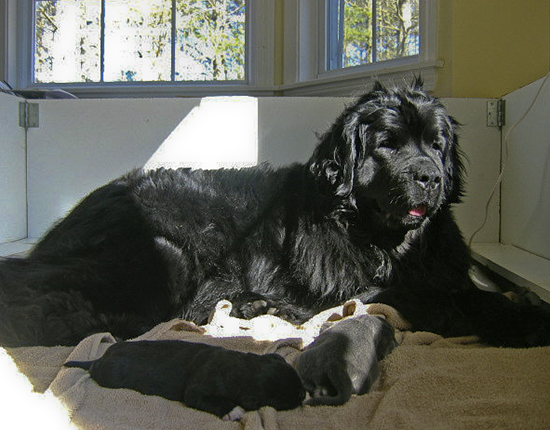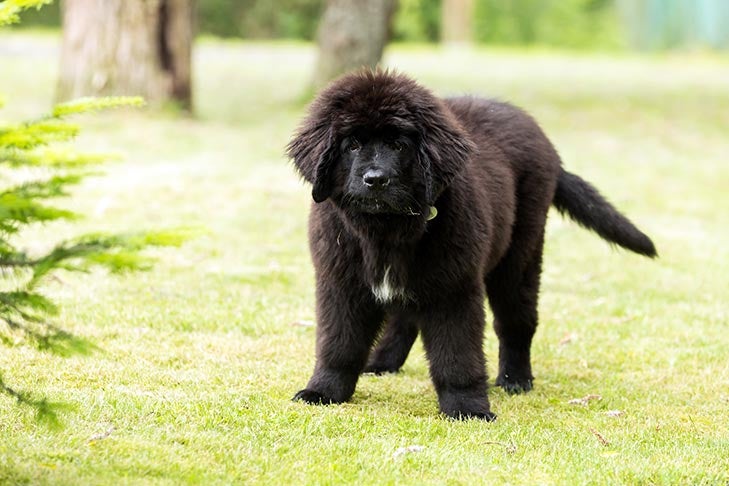The Newfoundland dog breed originates from the island of Newfoundland, now part of Canada. Bred as working dogs, they were initially used by fishermen for hauling nets, carrying loads, and even rescuing people from the water. Their exceptional swimming abilities and strength made them indispensable to the fishing communities along the coast. Over time, their gentle nature and loyalty led them to become popular family pets and therapy dogs.
Understanding Newfoundland Dogs: Colours, Characteristics, and Standards
There are two main kinds: black ones and black-and-white ones. There are also some that are bronze-colored, but they are rare.
The black Newfoundlands are mostly black, but many of them have white marks too. A white mark on the chest is typical for this breed. If a dog has white on its head or body, it belongs to the other breed, not the black one. The black colour should look dark and almost brownish.
In the other variety, there can be black and tan dogs, bronze ones, and black-and-white ones. The black-and-white ones are most common, and their markings are very important for how they look. They should have a black head with a white muzzle and stripe, and their body and legs should be white with big patches of black on their back and hindquarters. They might also have small black spots on their body and legs.

Apart from colour, the varieties should conform to the same standard. The head should be broad and massive, but in no sense heavy in appearance. The muzzle should be short, square, and clean cut, eyes rather wide apart, deep set, dark and small, not showing any haw; ears small, with close side carriage, covered with fine short hair (there should be no fringe to the ears), expression full of intelligence, dignity, and kindness.
Physical Characteristics
Size:
Newfoundlands are one of the largest dog breeds, with males typically weighing between 130-150 pounds and females ranging from 100-120 pounds. They stand about 26-28 inches tall at the shoulder.
Coat:
Newfies have a thick, double-layered coat that is water-resistant. This coat helps them stay warm in cold water and makes them excellent swimmers. Their fur comes in several colors, including black, brown, gray, and Landseer (white with black markings).
Build:
These dogs have a strong, muscular build with a broad chest and large paws. Their webbed feet are another feature that enhances their swimming capabilities.
The dog’s body should be long, square, and very strong, with a solid back and strong loins. Their chest should be deep and wide, and their legs should be straight and powerful, though a bit shorter compared to their body length. Their legs should have round bones covered with strong muscles, and their feet should be big, round, and close together. The tail should only be long enough to reach just below their hocks (the joint in their hind legs), and it shouldn’t have any kinks or curl over their back. The quality of the coat is really important. It should be very thick, with lots of soft fur underneath. The outer coat should be somewhat rough and completely straight.

The appearance generally should indicate a dog of great strength, and very active for his build and size, moving freely with the body swung loosely between the legs, which gives a slight roll in gait.
Raising Healthy Newfoundland Puppies: Nutrition, Care, and Health Tips
When you’re raising puppies, start by feeding them soft foods like well-cooked rice mixed with milk once they’re old enough to lap it up. After that, introduce scraped lean meat. Newfoundland puppies need a lot of meat to grow properly. They should gain about 3 pounds per week, so they need plenty of food that builds flesh, bone, and muscle—both raw and cooked meat is good. Milk is okay too, but it should have extra casein to make it stronger.
To grow big, strong dogs with sturdy bones and muscles, it’s important to give them a good beginning right after they’re born. This means feeding them well, keeping them in warm and dry places, and giving them space to move around and play freely. Don’t force them to exercise too much, as that can cause problems with their legs.
Medicine should not be required except for worms, and the puppies should be physicked for these soon after they are weaned, and again when three or four months old, or before that if they are not thriving. If free from worms, Newfoundland puppies will be found quite hardy, and, under proper conditions of food and quarters, they are easy to rear.
Health and Care
Common Health Issues:
Like many large breeds, Newfoundlands are prone to certain health conditions, including hip and elbow dysplasia, heart issues like subvalvular aortic stenosis (SAS), and cystinuria, a genetic kidney disorder. Regular veterinary check-ups, a balanced diet, and maintaining a healthy weight can help manage these risks.
Grooming:
Their thick, double coat requires regular grooming to prevent matting and reduce shedding. Brushing your Newfoundland at least 2-3 times a week is recommended, with more frequent grooming during shedding seasons. Bathing should be done as needed, typically every 1-2 months, depending on their activity level and coat condition.
Diet:
Newfoundlands need a diet tailored to large breeds, particularly during their puppy stage when they are growing rapidly. Overfeeding can lead to obesity and exacerbate joint problems, so it’s important to follow your veterinarian’s guidance on portion sizes and feeding schedules.
Living Environment
Newfoundlands are best suited for homes with ample space, ideally with a large yard where they can roam and play. They are adaptable to indoor living but thrive in environments where they have access to both indoor comfort and outdoor activity. Due to their size, they may not be well-suited for apartment living unless there is a commitment to providing them with adequate exercise and space.
Training and Socialization
Training a Newfoundland is generally straightforward due to their intelligence and desire to please. Positive reinforcement methods work best, as these dogs respond well to praise and rewards. Early socialization and obedience training are crucial to ensure they grow into well-mannered adults, particularly given their large size.
Is a Newfoundland Right for You?
If you’re looking for a large, loving, and loyal companion, the Newfoundland might be the perfect breed for you. They are best suited for families who have the space and time to dedicate to their care and exercise needs. Their gentle nature makes them ideal for families with children, and their protective instincts can provide an added sense of security. However, their size and grooming needs require a commitment to regular maintenance.
Find Your Perfect Newfoundland Puppy: Top Resources for Newfoundland Puppies and Dogs for Sale in USA
Are you looking to bring home a Newfoundland puppy? Whether you’re searching for a classic Newfoundland, exploring newfiedoodle breeders, or seeking reputable Newfoundland dog breeders, there are excellent resources to help you find the ideal companion. Websites like AKC Marketplace, Lancaster Puppies, Puppies.com, Good Dog, and Greenfield Puppies offer comprehensive listings of Newfoundland puppies for sale, ensuring you have a wide selection to choose from.
Additionally, specialised breeders like Moore Newfies and referrals from the Newfoundland Club of America provide trusted sources where you can find healthy and well-bred Newfoundland puppies. Explore these options to discover your new furry friend and start your journey with this beloved breed!
- AKC Marketplace – https://marketplace.akc.org/puppies/newfoundland
- Lancaster Puppies – https://www.lancasteranimalsale.com/newfoundland-puppies-for-sale
- Puppies.com – https://www.puppies.com/newfoundland-puppies-for-sale
- Good Dog – https://www.gooddog.com/newfoundland-puppies-for-sale
- Greenfield Puppies – https://www.greenfieldpuppies.com/newfoundland-puppies-for-sale
- Moore Newfies – https://www.moorenewfies.com/
- Newfoundland Club of America Breeder Referral – https://www.newfoundlandclubofamerica.org/breeders/
- Local Newfoundland breed clubs – https://www.ncanewfs.org/index.html





Leave a Reply